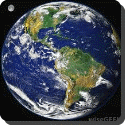 If you have ever been lost in a city or even a large town without the help of a street plan you will have some idea of the problems which confronted scientist of old when they tried to imagine exactly where Earth was in the Universe. You might be able to work out where you were in the city if you could climb on to a very tall building and have a bird’s eye view of the city as a whole. In the same way, if you could detach yourself from Earth and looks at it from space you would be able to see where it is.
If you have ever been lost in a city or even a large town without the help of a street plan you will have some idea of the problems which confronted scientist of old when they tried to imagine exactly where Earth was in the Universe. You might be able to work out where you were in the city if you could climb on to a very tall building and have a bird’s eye view of the city as a whole. In the same way, if you could detach yourself from Earth and looks at it from space you would be able to see where it is.
The Earth moves around the Sun but this was not at all obvious to our ancestors and it has taken many generations of scientific though to devise and accurate ‘street plan’ of space which pinpoints the Earth’s position correctly. Like us, our forefathers could look up at the night sky and observe a constantly changing pattern of bright objects including the much larger Moon. We know now that the Earth is just one of nine planets which together with their satellites (moons), a belt of smaller rocky bodies called asteroids, some meteors which appears to us as shooting stars, and one or two comets are all orbiting around the Sun some 140 million kilometers away.
The solar system. But what of all the other myriad points of light which we usually refer to simply as stars? From the vantage point of Earth, these stars appear to be arranged in patterns which have been given names like the Plough because of their resemblance in outline to more familiar objects. These patterns are called constellations but they may be made up of stars which are many millions of kilometers from each other.
In fact, each one of these pin pricks of light is a sun very similar to our own except that some of them are yoiunger and cooler and appear to be red in color and others are hotter, older, and blue. Our solar system is just one of many similar systems which all fit into a larger arrangement called a galaxy, and there are millions of other galaxies in the Universe. It has only been with the coming of the telescope in the 1600s and more recently radio telescopes and satellites that we have been able to establish our ‘street plan’.Our ancestors believed that the Earth was at the center of things. Some ancient civilizations believed that our planet was supported by huge animals such as elephant and whales. They could be forgiven for thinking that the sky was like a gigantic domed roof with the sun, the other planets and the stars suspended from it.
 Kids Portal For Parents India Kids Network
Kids Portal For Parents India Kids Network






